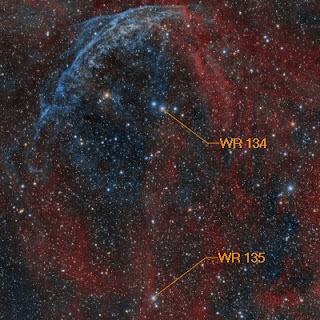The so-called Wolf-Rayet stars are a rare set of stars characterised by highly unusual spectra, marked by prominent broad emission lines of ionised helium, nitrogen or carbon. Their surface temperatures range from 20.000 K to over 200.000 K, far exceeding those of most other types of stars.
 In 1867, from the Paris Observatory using the 40 cm Foucault telescope, French astronomers Charles Joseph Étienne Wolf and Georges Antoine Pons Rayet visually observed (prior to the widespread use of photographic plates) the spectra of three eighth-magnitude stars in the constellation Cygnus. To their surprise, the spectra displayed very broad emission lines rather than the far more common absorption lines or bands. These stars would later be designated Wolf–Rayet (WR) stars.
In 1867, from the Paris Observatory using the 40 cm Foucault telescope, French astronomers Charles Joseph Étienne Wolf and Georges Antoine Pons Rayet visually observed (prior to the widespread use of photographic plates) the spectra of three eighth-magnitude stars in the constellation Cygnus. To their surprise, the spectra displayed very broad emission lines rather than the far more common absorption lines or bands. These stars would later be designated Wolf–Rayet (WR) stars.
The stars they identified were HD 191765, HD 192103 and HD 192641, now known respectively as WR 134, WR 135 and WR 137. In the first image on the right. WR 134 and WR 135 can be seen, lying less than one degree apart, The third, WR 137, lies outside the current field of view but can be found in my earlier RGB image of the region.
WR 134 is located approximately 6.000 light-years from Earth and is surrounded by a faint nebulous bubble, shaped by the star’s intense radiation and powerful stellar wind (*). Though only about five times the radius of the Sun, its temperature exceeds 63.000 K, and its luminosity is roughly 400.000 times greater than that of our Sun.
WR 134 is also a variable star, classified as an Algol-type eclipsing binary, with the designation V1769 Cygni.
(*) Today seems that it is still unclear which of the two stars, WR 134 or WR 135, is primarily responsible for creating the shell (For example, have a look at this).
My image is presented in the Ha-OIII-OIII palette (with RGB stars "taken" from this image) and accumulates 33 hours of exposure time. As usual, I first calibrated the image with SpectrophotometricColorCalibration, but then modified the balance of the G and B channels to get a more pleasing (subjective) view. Since the OIII component of the nebula is so weak, I gave a little more time to the exposure with this filter (18 h OIII vs. 15 h Ha), but it is now clear to me that it was not enough.New Narrowband Version, updated June 2025Image processing: Pixinsight.
Observatory automation and remote operation with Talon6.




No comments:
Post a Comment